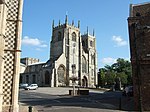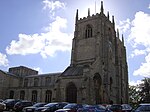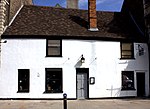Our Lady of the Annunciation Church, King's Lynn
1845 establishments in England19th-century Roman Catholic church buildings in the United KingdomGothic Revival architecture in NorfolkGothic Revival church buildings in EnglandGrade II listed Roman Catholic churches in England ... and 5 more
Grade II listed churches in NorfolkKing's LynnRoman Catholic churches completed in 1897Roman Catholic shrines in the United KingdomShrines to the Virgin Mary

Our Lady of the Annunciation Church is a Roman Catholic parish church in King's Lynn, Norfolk, England. It was built in 1897, but incorporates parts of the former church on the same site that was built in 1845 and designed by Augustus Pugin. It is located on the corner of London Road and North Everard Street in the centre of the town. Its construction was partially paid for by the then Prince of Wales, Edward VII. It was also the national shrine of Our Lady of Walsingham until 1934. It is now a pontifical shrine, and was awarded Grade II listed status in 2022.
Excerpt from the Wikipedia article Our Lady of the Annunciation Church, King's Lynn (License: CC BY-SA 3.0, Authors, Images).Our Lady of the Annunciation Church, King's Lynn
London Road, King's Lynn and West Norfolk South Lynn
Geographical coordinates (GPS) Address Website Nearby Places Show on map
Geographical coordinates (GPS)
| Latitude | Longitude |
|---|---|
| N 52.7482 ° | E 0.4023 ° |
Address
Our Lady of The Annunciation (Catholic Church)
London Road
PE30 5HQ King's Lynn and West Norfolk, South Lynn
England, United Kingdom
Open on Google Maps








